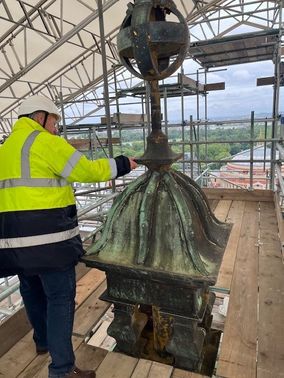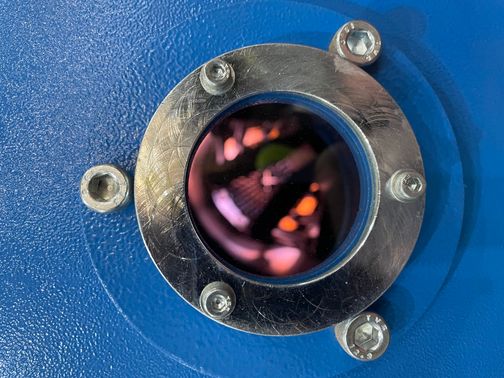High profile projects
De-steaming
A bold project removing a significant amount of legacy steam generating infrastructure from South Kensington Campus and upgrading what is one of the largest Low Temperature Heating System networks in London is nearing completion. Ultimately this will reduce Imperial’s carbon dioxide emissions by circa 2,400 tonnes/year and save over £1.341m per year after implementation, helping towards our 2040 net zero target.
Three new permanent boilers are being integrated into the heating and water network, allowing us to switch off two of the temporary boiler sites we have been relying on over the winter.
As well as the near switch over to the permanent boilers, we are also at the point where all steam has been removed from the buildings.
We will soon begin decommissioning temporary services and removing these from campus, which will visibly start to return to normal as a result.
See the latest news article on our webpages.
Net Zero decarbonisation programme
This ambitous programme supporting Imperial's Net Zero by 2040 targets is getting underway.
Arup report Our journey to a net zero estate by 2040
Energy saving lighting installation
To reduce carbon emissions the first action necessary is to reduce demand – and in the most cost-effective way.
Under the de-carbonisation programme we have drawn up, that means saving power on lighting, through making the switch to LED.
While our new-builds are fitted with LEDs, and as we’ve refurbished in other areas we’ve upgraded, we are embarking on the first series of interventions carried out without it being part of other work.
Please see the tab below for more information.
Solar panel installation
Silwood Park operates controlled-environment chambers that are used primarily for growing plants and insects, including chambers with temperature, humidity, and light control. Facilities include greenhouses, controlled environment rooms, a Fitotron and smaller incubators.
These energy hungry research facilities are to benefit from our first solar panel installation. All power generated by the installation to be used by the building.
Look out for more details of our programme.
Queen's Tower
The repair and restoration of the iconic Queen's Tower, the much-loved symbol of Imperial is continuing.
Click on the tabs below for more details.
You can view Fact Sheets, campus project plans and programmes currently being worked on here at Imperial. For information on individual projects, please open the project's fact sheet below.
Current projects
- Repairing the Queen's Tower
- Campus programmes and plans
- Decarbonisation of SK Campus
- Arup decarbonisation programme
- Energy saving upgrades
Queen's Tower restoration
At the heart of our South Kensington Campus the Queen’s Tower, which is more than 140 years old, is the last remaining part of the original Imperial Institute building. Repairs are required to the masonry and the copper roofing is being replaced.
The scaffolding will provide access for a full survey of the tower and for the comprehensive cleaning of the stonework. Once it has been cleaned, the detail repairs to the stonework will be confirmed and undertaken. The opportunity will also be taken to replace the timber louvres around the bell chamber and to repair or replace the flat roofs to the balconies.
The length of scaffolding being erected around the Queen’s Tower is 60km. This would stretch from South Kensington to our Silwood Park campus via White City, St Mary’s, Charing Cross, Hammersmith and the Chelsea and Westminster hospital campuses if the scaffold tubing were laid end-to-end.
The perimeter hoarding, the loading bay that you see, along with protocols for noise management will help minimise the disruption to the campus.
When the scaffolding is dismantled the stone steps and plinth will then be repaired.
The works are now scheduled to complete in January 2026, while every effort to bring that forward will be made.
This project will provide at least 50 years of further life to the external fabric of the highly visible icon of Imperial.
You can download details of the project from the highlight button on this page.
Read more about the restoration work in People, Places, Spaces magazine.
Watch the latest time lapse of the scaffolding as it reaches the top of the Queen's Tower
Watch the work underway on the tower on YouTube.
A time lapse video of work up until March 2023
Watch a time lapse video of work on the tower until April 2023
South Kensington Campus Coordination Plan [PDF]
Removing steam and reducing our carbon emissions
A bold project removing a significant amount of legacy steam generating infrastructure from South Kensington Campus and upgrading one of the largest Low Temperature Heating System networks in London is nearing completion.
South Kensington Campus is home to one of London’s largest Combined Heat and Power (CHP) stations. The 60-year-old steam network and quarter of a century old boilers have now been removed and three heat networks have been consolidated into one which means:
- 180oC steam has been removed from circulation around the campus and plant rooms
- Carbon dioxide emissions will reduce by circa 2,400 tonnes/year and save over £4m per year
- This will help Imperial met net zero carbon by 2040.
Following testing and confirmation that the new permanent boilers were successfully up and running, steam and Low Temperature Hot Water boiler and fuel tanks have each been removed from the temporary sites by Blackett and ACE buildings and four LTHW boilers from Skempton and Library locations, and flues removed.
During the coming weeks, scaffolding then hoardings will also disappear.
The final phase of removal of remaining temporary infrastructure can then begin. (updated 21.6.24)
Past articles charting this project:
You can read our latest update on the project on our news pages.
You can read more about this grant and match funded project on our news pages.
The Imperial estate is huge. There are more than 100 buildings including residences, spread over eleven campuses and other sites. Because of that complexity our decarbonisation plan to achieve Net Zero by 2040 had to be drawn up with the help of experts. Consultants Arup have been working with us on this for more than a year. Arup surveyed our estate, ruled out buildings that are new, (White City South Campus is already designed to be fossil-fuel free and low carbon) or set to be replaced, or decommissioned. They were able to identify where spending will have the most impact and can be done ‘early, next and later’ (later tending to mean expensive and less cost-effective infrastructure works).
Our plans have been approved by University Management Board, and we will beginning on those works identified for the next five years shortly.
You can download a summary of the report in the tab on this page.
LED lighting
Work is beginning on upgrades to low energy (LED) lighting as part of our Net Zero prgramme.
The basic principle is that to reduce carbon emissions the first action necessary is to reduce demand – and in the most cost-effective way.
Under the de-carbonisation programme we have drawn up, that means saving power on lighting, through making the switch to LED.
While our new-builds are fitted with LEDs, and as we’ve refurbished in other areas we’ve upgraded, our LED upgrade programme will be the first series of interventions carried out without it being part of other work.
First to benefit are Flowers and Electrical Engineering buildings on South Kensington Campus.
Solar panels
Silwood Park operates controlled-environment chambers that are used primarily for growing plants and insects, including chambers with temperature, humidity, and light control. Facilities include greenhouses, controlled environment rooms, a Fitotron and smaller incubators.
These energy hungry research facilities are to benefit from our first solar panel installation. All power generated by the installation to be used by the building.
Look out for more details of our programme.
Current visible projects on South Kensington Campus

Scaffolding is being erected for the repair and restoration of the Queen's Tower

The viewing porthole with the flame alight in the 10-megawatt new boiler in the Energy Centre
.jpg)